Q-See QC9416, QC824, QC818, QC9116, QC838 Remote Monitoring Guide
...
Setup Guide for Remote Internet and Smartphone Monitoring, MyQ-See DDNS, and Email Notification
PC with Windows
Operating System
Apple Macintosh
Computer
iOS
Android
QC SERIES DVR & NVR MODELS
REMOTE MONITORING SETUP GUIDE
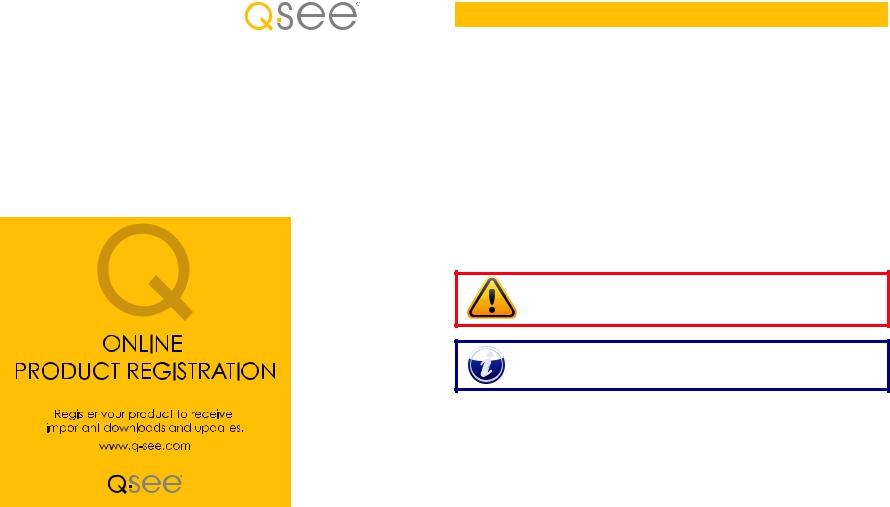
Thank You for Choosing a Q-See Product!
Our products are backed by a 2-year conditional service warranty covering all hardware from the original date of purchase. We offer free lifetime software and firmware upgrades for your system online at www.Q-See.com.
Be certain to make the most of your warranty by completing the registration form online. In addition to warranty and technical support benefits, you’ll receive notifications of product updates along with free downloadable firmware updates for your NVR or NVR. Register today at www.Q-See.com!
© 2011-14 Q-See. Reproduction in whole or in part without written permission is prohibited. All rights reserved. This manual and software and hardware described herein, in whole or in part, may not be reproduced, translated, or reduced to any machine-readable form without
prior written approval.
Trademarks: All brand names and products are trademarks or registered trademarks of their respective owners.
Q-See is a registered trademark of DPS, Inc.
Disclaimer: The information in this document is subject to change without notice. The manufacturer makes no representations or warranties, either express or implied, of any kind with respect to completeness of its contents.
Manufacturer shall not be liable for any damages whatsoever from misuse of this product.
2
About this Manual
This manual is written for the QC series of Analog DVRs, AnalogHD DVRs and NVRs. It was accurate at the time it was completed. However, because of our ongoing effort to constantly improve our products, along with smartphone and router manufacturers adding and changing features on their products, it is possible that some functions may change from how they are described. We encourage you to visit our website at www.Q-see.com to check for the latest firmware updates and product announcements.
This manual covers the remote access and monitoring of your system over the Internet via a computer or mobile device. Instructions for setting up, configuringand local control of your system are contained within the User Manual which is included on the CD that
accompanied your system and which can also be found on www.Q-See.com/support. The User Manual will be referred to frequently within this Remote Monitoring Guide so it is recommended that you have that document available as well.
Throughout the manual we have highlighted warnings and other important information that will assist you in operating your new system in a safe and trouble-free manner. Please take the time to read and follow all instructions and pay attention to alerts as shown below:
IMPORTANT! Red boxes with this icon indicate warnings. To prevent possible injury or damage to the product, read all warnings before use.
NOTE! Text in blue boxes with the Information icon offer additional guidance and explanations about how to make the most out of your system.
DVRs and NVRs
The three types of systems covered in this manual use diffferent technolgies and have different capabilities, but the operating system is identical as is way you connect them to the Internet. For the purposes of this manual, the terms “DVR”, “System” and “Recorder” will be used to refer to both DVRs and NVRs. If a feature is specific to either a DVR or NVR, it will be pointed out as applying to that type of recorder.
Every effort has been made to make this manual easy to understand and follow. However, if you should run into any difficulties during any of these operations, we are here for you.
QUESTIONS OR COMMENTS? CONTACT US
24/7 TECHNICAL RESOURCES, KNOWLEDGE BASE AND MORE www.Q-See.com/Support
Version 3.0 2/20/14
3

TABLE OF CONTENTS
1. REMOTE ACCESS |
6 |
1.1 Connecting Your System to a Network |
7 |
Before you get started |
7 |
Obtaining an IPaddress |
7 |
1.2 Opening Ports |
9 |
Option 1: UPnP |
9 |
Option 2: Opening Ports Using DMZ |
10 |
Option 3: Opening Ports Using DMZ on 2Wire Routers |
11 |
Confirming That Ports are Opened |
12 |
1.3 Static Internal IP (Network) Address |
13 |
1.4 PPPOE |
14 |
1.5 Domain Name System (DNS) |
15 |
1.6 Dynamic Domain Name Service (DDNS) |
17 |
1.7 Resolving Connection Issues |
18 |
Determine the Number of Routers on the Network |
18 |
Setting Up DMZ in Router 2 |
20 |
2. ADDITIONAL SETTINGS |
21 |
2.1 Advanced Network Settings |
21 |
Online Users |
21 |
Block/Allow List |
22 |
23 |
|
FTP |
24 |
3. REMOTE MONITORING |
26 |
3.1 Web Service |
26 |
ActiveX for Internet Explorer |
26 |
3.2 Using Web Service |
29 |
Live Viewing |
30 |
Playback |
37 |
Alarm |
38 |
Setup |
39 |
info |
46 |
Logout |
46 |
3.3 Pro Surveillance Software (PSS) |
49 |
System Requirements |
49 |
Installing Smart PSS on a PC |
49 |
Installing Smart PSS on a Macintosh |
50 |
Log In |
50 |
Adding A System to PSS |
51 |
Home Page |
54 |
Preview |
55 |
Video Search and Playback |
57 |
Alarms |
59 |
General |
61 |
Device Setup |
61 |
Tour |
64 |
E-Map |
65 |
TV Wall |
66 |
PC-NVR |
66 |
4. MOBILE SURVEILLANCE |
67 |
4.1 iPhone and iPad |
67 |
4.2 Android |
74 |
4 |
5 |

REMOTE ACCESS |
CHAPTER 1 |
In order to access your DVR remotely, you must connect it to a router or a modem. Using a router allows you to connect to your DVR from other computers on your LAN (Local Area Network) in addition to over the Web. Directly connecting to a modem makes your DVR available for connection through the Internet only.
If you are using a router and wish to access your DVR from outside your LAN either over the Internet, or from your mobile device, then that router must be connected to the Internet. The instructions below will guide you through the process of configuring your DVR for remote access. Once completed, you will be able to access and control your system using one of two addresses. You will have a local IP address usable by computers connected to the same router as your DVR. This address can also be used by wireless devices as long as they are able to also connect to your router’s WiFi signal. Once you leave the area covered by your local network, you will need to use a second address to access the DVR. This is the address which will allow you to connect to your system from anywhere in the world with Internet access. And, by using Q-See’s free DDNS service, MyQ-See.com (more on this later), you’ll be able to do so using a conventional web address.
If you are using a router, proceed with Section 1.1. If you are connecting directly to the Internet via a modem then begin with Section 1.4.
NOTE! The minimum speed on the internet connection is 1Mbps download and 1Mbps upload for 4 and 8 channels, and 2Mbps download and upload for 16 channels. You can check the speed of your connection at both ends by
going www.SpeedTest.net from both a computer attached to the same router as the DVR as well as the remote computer which you will be using.
Startup Wizard and the Remote Monitoring Quick Start Poster
If you were able to connect your computer to your network, and to the Internet, using the Startup Wizard when you powered up your DVR, you should skip to Section 1.3 Static Internal IP Address in order to ensure that your network address does not change in the event of a power outage.
Likewise, if you were able to successfully connect using the Startup Wizard, then the DVR was able to connect using UPnP, or Universal Plug ‘n Play and your ports have already been opened. In this case, it is very important to NOT attempt to open your ports as that will cause communication errors between your DVR and the network, possibly preventing reliable remote access.
If you were unable to connect to your network, the most likely cause is UPnP being disabled, or not available on your router. Two alternate connection options are presented for PC users on the Remote Monitoring Quick Start Poster. They are also presented again in Section 1.2 Opening Ports, along with instructions for Maciintosh users.
1.1 CONNECTING YOUR SYSTEM TO A NETWORK
First and foremost, you will need to physically connect your DVR to a router. This router can be part of an existing network of computers, or it can be the router/modem supplied by your Internet Service Provider (ISP) to connect you to the Internet. This connection will be made by plugging the included Ethernet cable into the port on the back of the DVR marked RJ45. Your DVR is not designed to be connected wirelessly to a network. It is also recommended that the router that the DVR is connected to should be connected directly to the Internet rather than to another router if Internet access is desired as multiple routers can create problems with connectivity. You will also need to have a computer connected to the same router - at least temporarily - to make certain settings. If, after following the instructions you are still not able to access your DVR, please see Section 1.7 Resolving Connection Issues later in this chapter.
BEFORE YOU GET STARTED
You will need to have:
•Your router’s brand, model number and manual. The manual is also usually available on your router’s manufacturer’s website.
•The “Manuals and Software” CD that came with your DVR. It contains necessary software and links to other important programs which are mentioned in this guide.
•Your router’s password (the default password should be in your router’s manual).
OBTAINING AN IP ADDRESS
Each device on a network - both a LAN or the Internet - has a specific IP address. This address is what allows different devices on the network to communicate with each other. Your QC-series DVR displays its IP address in the Network window.
STEP 1. Select Main Menu from the
Shortcut Menu.
PICTURE 1-1
STEP 2. Click on the Network Settings icon in the Main Menu
PICTURE 1-2
6 |
7 |
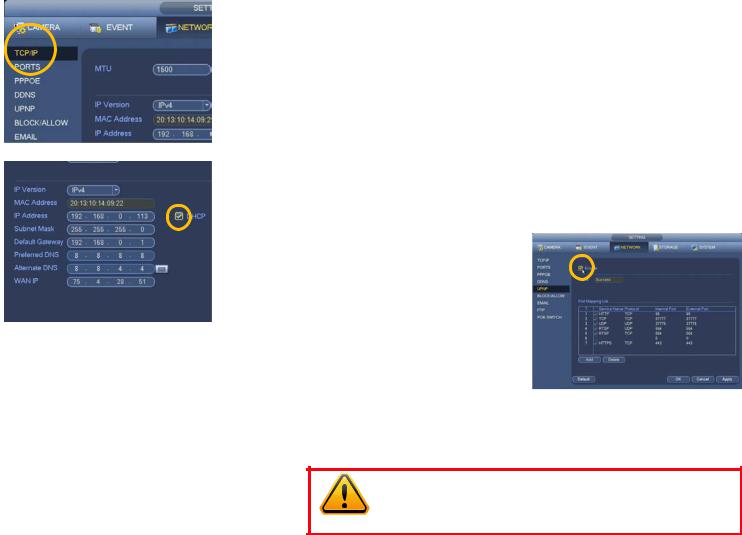
STEP 3. Click on the Network icon in the Settings Menu.
STEP 4. Ensure that the box labeled “DHCP” is filled.
If it is not, please put a click on the box so that it is filled in white. Click on Save and then exit the window. Reopen the window to see the updated IP address.
STEP 5. Write down the:
1.DVR’s IP Address
2.Subnet Mask, and
3.Gateway (your Router’s address)
STEP 6. Exit Menu
PICTURE 1-3
1
2
3
PICTURE 1-4
You may now proceed to Section 1.2 Opening Ports. However, if you are unable to obtain an IP address from your router, please proceed to Section 1.3 Static IP.
1.2 OPENING PORTS
To make your DVR accessible from outside of your local network, you have to “forward” ports 85 and 3777 through your router to your DVR’s IP address. The most preferred - and easiest - method is UPnP. This is the method used by the Startup Wizard and for most users, the DVR should connect automatically. If not, we offer some other methods which should work for the majority of users. You will only need to use one of these methods - which are the same if you are using a Macintosh or Windows PC. If you are unable to connect your DVR to the Internet using any of these procedures, the likely cause is the presence of multiple routers on your network. The solution is covered in Section 1.7 Resolving Connection Issues.
OPTION 1: UPNP
The QC series of DVRs come configured to take advantage of the latest networking technology, UPnP or Universal Plug ‘n Play right out of the box. If you have an UPnP-enabled router, you will only need to plug the DVR into your network and you will then be able to proceed to the end of this section.
Consult your router’s manual to determine whether it has UPnP or not. Please note that, as of this writing, 2Wire brand routers do not have the UPnP feature. If you do not have a UPnP-enabled Router, you will have to utilize another method to forward your ports.
If you wish to ensure that UPnP is turned on in your DVR, go to the Network window as described above, select UPnP on the
left and make sure that the Enabled box is
checked. If it is not checked, click on the box PICTURE 1-5 to add the check, then click on Save before
exiting the window. When you reopen the window, the box should be checked.
IMPORTANT! If you connect your system to your network using UPnP you should NOT forward your ports as described later in this section as it will create connectivity problems. You may skip to Confirming that Ports are Opened.
8 |
9 |
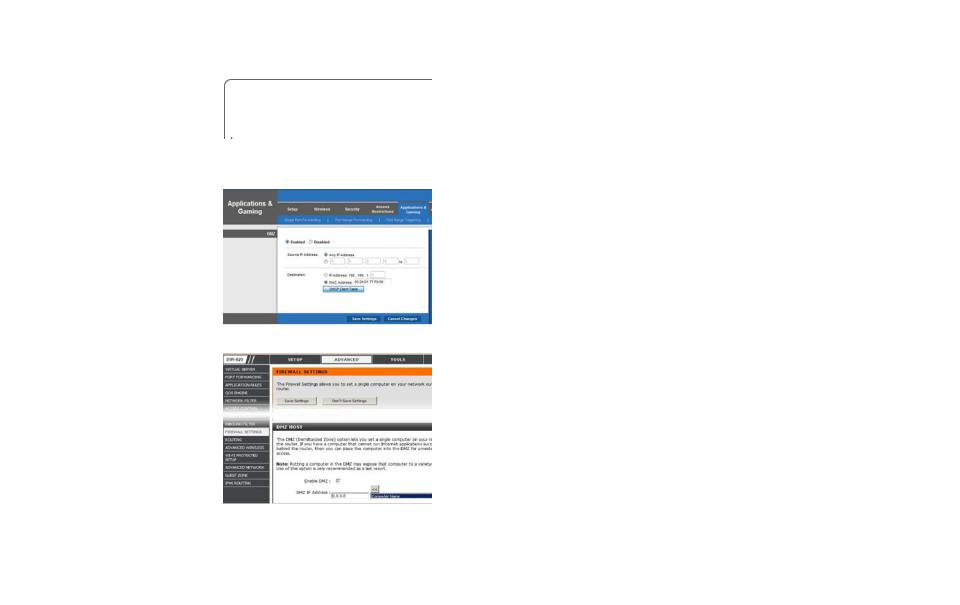
OPTION 2: OPENING PORTS USING DMZ
Accessing your router’s DMZ controls:
The exact location of DMZ within the router’s settings vary by manufacturer so please consult your router’s manual for the location of this feature. The method for accessing your router’s settings, however, is pretty standard.
NOTE! If you are an AT&T Internet or Uverse customer, you should follow the instructions laid out in Option 3 as they specifically apply to the brand of router used by AT&T.
STEP 1. On a computer connected to the same router as the DVR, open a web browser and enter the Gateway (Router’s IP address) into the browser window’s address bar to access your router.
STEP 2. Locate the DMZ settings in your router. Each manufacturer is different so please consult your router’s manual for the location of this setting. Two examples are shown at right.
STEP 3. Enable DMZ.
STEP 4. Enter the NVR’s IP address.
STEP 5. Click on Apply or Save to preserve your settings.
Leave your router control panel open as you will need to obtain DNS information from your router in Section 1.5 Domain Name System (DNS). You should now proceed to the section entitled Confirming that Ports are Opened.
 Browser - Windows Internet Explorer
Browser - Windows Internet Explorer
http://10.6.196.6
PICTURE 1-6
PICTURE 1-7
PICTURE 1-8
NOTE! Specific instructions for setting up DMZ in 2Wire, Airport, Dlink, Linksys, Netgear, and other brand routers can be found at www.Q-See.com/Network
OPTION 3: OPENING PORTS USING DMZ ON 2WIRE ROUTERS
Accessing your router’s DMZ controls:
2Wire brand routers are currently the exclusive router used for AT&T’s Uverse and other Internet servers. Their configuration protocols are different enough that you should follow these instructions rather than the generic router instructions in Option 2 if you are an AT&T customer.
STEP 1. On a computer connected to the same router as the DVR, open a web browser and enter the Gateway (Router’s IP address) into the browser window’s address bar to access your router.
STEP 2. Click on the Settings tab and then Firewall. Once in Firewall, click on Applications, Pinholes and DMZ.
STEP 3. In the Select Your Computer area, locate your DVR’s IP address and click on it.
STEP 4. Scroll down to select User Defined.
STEP 5. Click on Add a new userdefined application.
STEP 6. In the box labeled Application Profile Name, enter “DVR”, “NVR” or another appropriate name.
STEP 7. Ensure that TCP is selected.
STEP 8. Enter 85 in the From and To boxes for Port (or Range).
STEP 9. Leave the next two boxes blank to use the default settings.
STEP 10. Click on Add to List. Your router will require you to log in to accept the settings. If you have not created your own password for your router, it is the 10-digit System Key printed on the label on your router between the square brackets “[ ]”.
 Browser - Windows Internet Explorer
Browser - Windows Internet Explorer
http://10.6.196.6
PICTURE 1-9
2
3
4 5
6
7-8
10
PICTURE 1-10
STEP 11. Once your settings have been confirmed, repeat Steps 8-10, this time entering 37777 for the From and To ports.
STEP 12. Click on Back and then select the name you entered in Step 6 from the list of Applications. Clicking on Add and then Save.
Leave your router control panel open as you will need to obtain DNS information from your router in Section 1.5 Domain Name System (DNS).
10 |
11 |
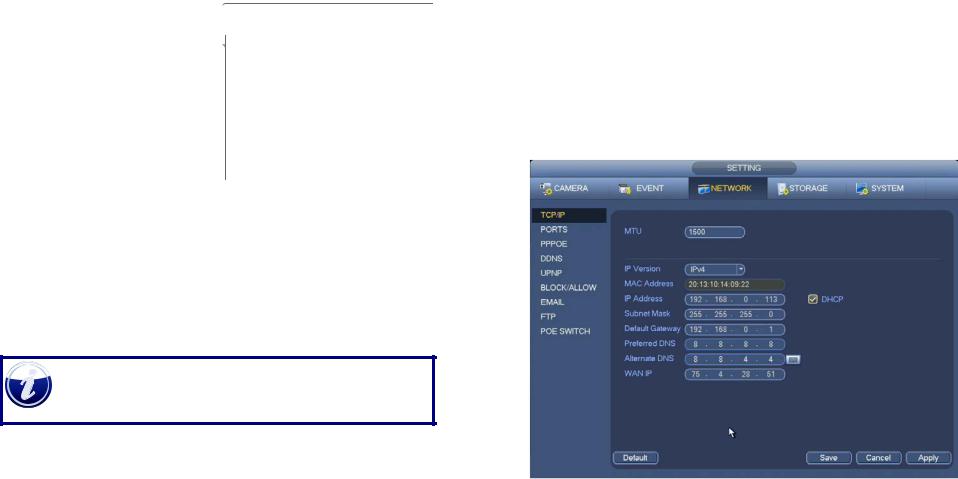
CONFIRMING THAT PORTS ARE OPENED
To confirm that your ports have been forwarded successfully, go to www.canyouseeme.org using a computer connected to the same router as the DVR.
STEP 1. Enter “85” into the box labeled “What Port?”
STEP 2. Click on the Check button.
STEP 3. You should see a green “Success” message. If not, return to the DVR’s Network window and, in the Network tab, change port 85 to 81 or 83 and click Apply to save your changes before checking using that new number on CanYouSeeMe.
STEP 4. Repeat for port 3777. If there is a problem with port 37777, then try 37000 in the same manner as above.
 Browser - Windows Internet Explorer
Browser - Windows Internet Explorer



 http://canyouseeme.org/
http://canyouseeme.org/
 Open Port Check Tool
Open Port Check Tool
CanYouSeeMe.org - Open Port Check Tool
This page will serve as a free utility for remotely verifying a port is open or closed. It be useful for users who wish to check to see if a server or ISP is blocking certain ports
Your IP: 81.919.622.24
What Port? 
Check
Success: I can see your service on
81.919.622.24 on port (85)
Your ISP is not blocking port 85
PICTURE 1-11
This website will also display your Public IP address near the top of the page above the box where you entered your port number. This is the number which you will use to access the NVR using a web browser or your mobile device from outside of your local network (away from the building in which your DVR is located).
NOTE! If you are successful after changing from port 85, then you will need to add that to the IP address when accessing the DVR via the Internet. If, for example, you changed to port 81 from 85, the address would now read 64.245.112.90:81
1.3 STATIC INTERNAL IP (NETWORK) ADDRESS
Most routers assign connected devices a random IP address that is not currently in use by another device on your internal network. With the exception of 2Wire brand routers, when a router or networked device reboots due to a power loss or other issue, the addresses will change and the port forwarding configuration will no longer work. For that reason, unless
you have a 2Wire router, we recommend changing your NVR’s network setting to a fixed, or “static” IP address which will not change.
STEP 1. Return to the Network Menu.
STEP 2. Select TCP/IP on the left.
STEP 3. Uncheck the box marked DHCP. STEP 4. Click Save.
Proceed to Section 1.5 Domain Name System (DNS) without closing the window.
PICTURE 1-12
12 |
13 |
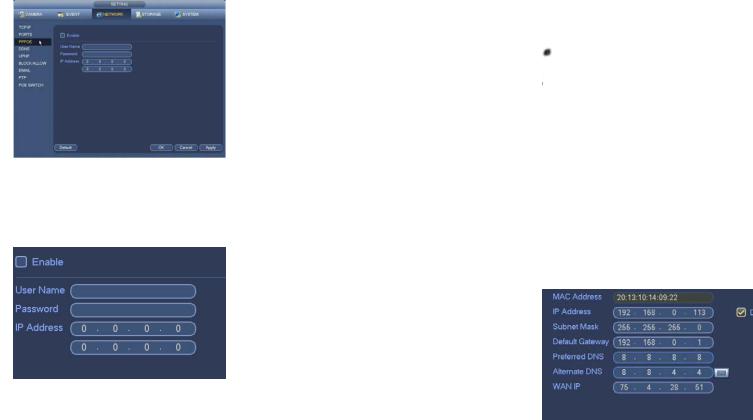
1.4 PPPOE
If you are going to attach the DVR directly to a DSL or cable modem instead of to a router then select the PPPOE option in the Network options. Before you proceed, you will need to contact your ISP to obtain your User Name and Password. You will not have to worry about Static IP (previous section).
STEP 1. Select the PPOE option on the left of the Network Settings window.
PICTURE 1-13
STEP 2. Click Enable
STEP 3. Input the User Name and
Password provided by your ISP into
their respective fields.
STEP 4. Click OK to save your settings. Click on Save in the Netwok window
before closing that window.
PICTURE 1-14
STEP 5. Restart your DVR and return to the PPOE window. Your NVR will have automatically connected to the Internet and you can use the number in the IP address field to remotely access the DVR.
1.5 DOMAIN NAME SYSTEM (DNS)
MACINTOSH AND PC USERS
Once you have completed the above sections, you are able to operate your DVR remotely. The sections below allow you to take advantage of additional features including the ability to access your DVR using a conventional domain name and having your system send out e-mail alerts. To access these functions, you will have to access your router to obtain your DNS (Domain Name System) number.
STEP 1. Return to your router’s control window.
If you did not have to open your router in a previous step, simply open a new browser window and enter the Gateway address (covered in
Section 1.1)
STEP 2. Locate your router’s status window (may also be named “Information” or “Info”, it will list the DNS number. You will only need to use the primary set of numbers - write it down for later use.
STEP 3. In the DVR’s Network window, enter the DNS number in the area marked Preferred DNS. You do not need to have an alternate server.
STEP 4. Click Save to save your settings.
Browser - Windows Internet Explorer |
|
|
|
||||
|
http://81.919.622.24 |
|
|
|
|||
Router |
|
|
|
|
|
|
|
|
|
|
|
|
|
|
|
|
|
|
|
SETTINGS |
|
STATUS |
|
|
|
|
|
|
|
|
|
DEVICE INFO |
|
|
DEVICE INFORMATION |
||||
|
|
|
|||||
LOGS |
|
|
All of your Internet and network connection details a |
||||
STATISTICS |
|
|
|||||
|
|
WAN |
|
|
|
||
INTERNET SESSIONS |
|
|
|
|
|||
|
|
MAC Address : 00:24:01:77:f9:00 |
|||||
ROUTING |
|
|
|
||||
|
|
|
|
IP Address : 81.919.622.249 |
|||
WIRELESS |
|
|
|
|
|||
|
|
|
Subnet Mask : 255.255.255.0 |
||||
|
|
|
|
Default Gateway : 81.919.622.24 |
|
||
|
|
|
|
Primary DNS Server : 10.6.196.6 |
|
||
|
|
|
|
Secondary DNS Server : (null) |
|
||
|
|
|
|
Advanced DNS : Disabled |
|||
|
|
|
|
|
|
|
|
PICTURE 1-15
PICTURE 1-16
14 |
15 |
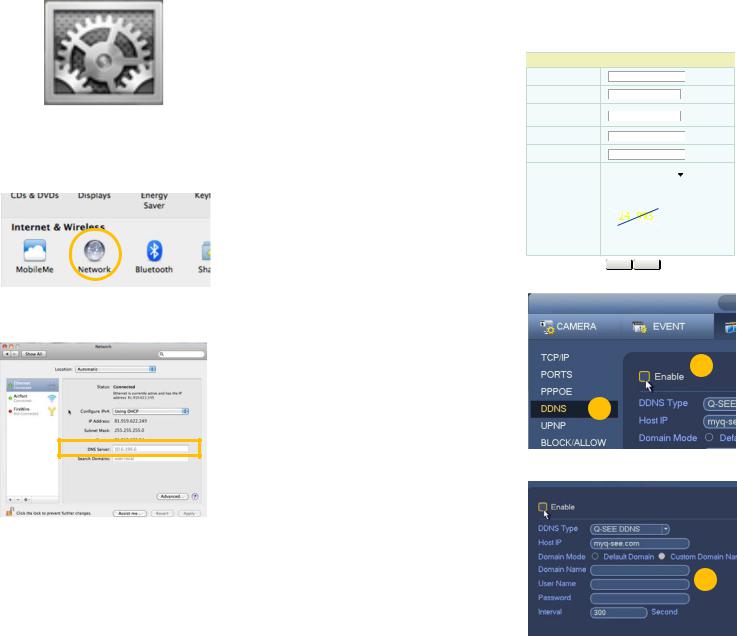
MACINTOSH COMPUTERS
In addition to retrieving the DNS info from the router, Macintosh users can get it from the computer’s Network window.
STEP 1. Click on the System Preferences icon at the bottom of the Macintosh’s screen.
PICTURE 1-17
STEP 2. Click on the Network icon.
PICTURE 1-18
STEP 3. Make sure that your network connection is highlighted in the list of connections to the right of the main part of the Network window and that its status reads “Connected.”
The DNS server information will be shown. Write this down for use in the next section.
PICTURE 1-19
1.6 DYNAMIC DOMAIN NAME SERVICE (DDNS)
This is an optional step which allows you to take advantage of Dynamic Domain Name Service, or DDNS. Not to be confused with DNS above, DDNS allows you to enter a conventional web address when remotely logging into your DVR from outside of your network. It also allows you to avoid having to repeat Sections 1.3 and 1.5 when/if your ISP reassigns IP addresses. Q-See offers DDNS service for free at www.MyQ-See.com and your DVR is configured to accept account information from that site.
STEP 1. Open a browser window and go to www.MyQ-See.com
STEP 2. Register with the website and follow the instructions for creating a domain name. The website will display your pubic IP address and
your domain name which will look like this: http://example.myq-See.com
STEP 3. In your DVR, open the Network window.
STEP 4. Select DDNS from the list on the left.
STEP 5. Check the Enable box.
STEP 6. Enter your account information
– including the user name and password that you used when creating your domain name .
STEP 7. Click the OK button to preserve your settings.
NEW USER REGISTRATION
EMAIL ADDRESS
PASSWORD
PASSWORD
CONFIRM
FIRST NAME
LAST NAME
SECURITY |
|
|
|
|
|
|
|
|
QUESTION.. |
My first phone number |
|
||||||
|
|
|
|
|
|
|
|
|
|
|
|
|
|
|
|
|
|
ANSWER |
|
|
|
|
|
|
|
|
|
|
|
|
|
|
|
|
|
|
|
|
|
|
|
|
|
|
CONFRIM |
|
|
|
|
|
|
|
|
|
|
|
|
|
|
|
|
|
|
|
|
|
|
|
|
|
|
New Captcha |
|
|||||||
YOU’RE HUMAN |
|
|||||||
|
|
|
|
|
|
|
|
|
|
Enter the text you see above |
|
||||||
Submit Reset
PICTURE 1-20
5
4
PICTURE 1-21
6
PICTURE 1-22
16 |
17 |
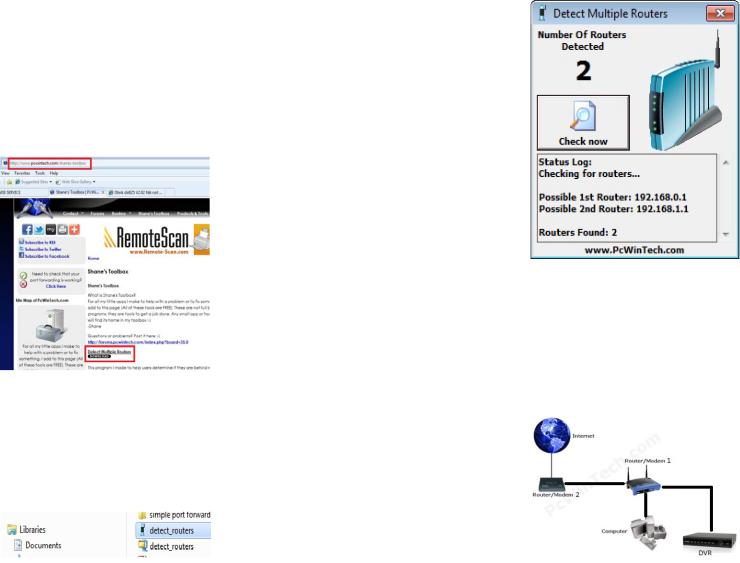
1.7 RESOLVING CONNECTION ISSUES
There are several hardware-related situations which can prevent the NVR’s port from being properly forwarded. The presence of multiple routers or the routers not featuring UPnP or DMZ are the two most common issues.
DETERMINE THE NUMBER OF ROUTERS ON THE NETWORK
STEP 5. Click on CHECK NOW to detect how many Routers are in the network.
If there is more than one router between the NVR and the Internet it will block communication
to and from your system. To find out the number of routers on your network, you will need to download a FREE router detection program.
STEP 1. Go to http://www.pcwintech. |
|
|
|
com/shanes-toolbox |
|
|
|
STEP 2. Click on Detect Multiple |
|
|
|
Routers to begin the download. |
|
|
PICTURE 1-25 |
|
|
STEP 6. If there is only one router detected, and you are using UPnP, then you will need |
|
|
|
to turn off that setting and attempt to connect using DMZ as described in Section |
|
|
|
1.2 Opening Ports. |
|
|
|
If you are using DMZ, check to make sure that the UPnP option is turned off. |
|
|
|
|
|
STEP 3. Unzip the application to install it. |
PICTURE 1-23 |
|
|
|
|
|
|
|
|
If Multiple Routers are Detected |
|
|
|
If there are multiple routers, you will see a |
|
|
|
display similar to Picture 1-26. |
|
|
|
If so, it may be preferable to connect your |
|
|
|
DVR and computer to the router that |
|
|
|
connects directly to the Internet. However, |
|
|
|
this is not always possible depending upon |
|
STEP 4. Click on the detect_routers |
|
your particular situation. |
|
|
|||
|
|
|
|
application to run it. |
|
|
|
|
|
|
|
|
PICTURE 1-24 |
|
|
|
|
PICTURE 1-26 |
|
|
|
In this case, you will need to proceed with the next section and set up DMZ in the second |
|
router to allow communications to pass through it from the first. If only one router is detected you will need to consult your router’s manual.
18 |
19 |
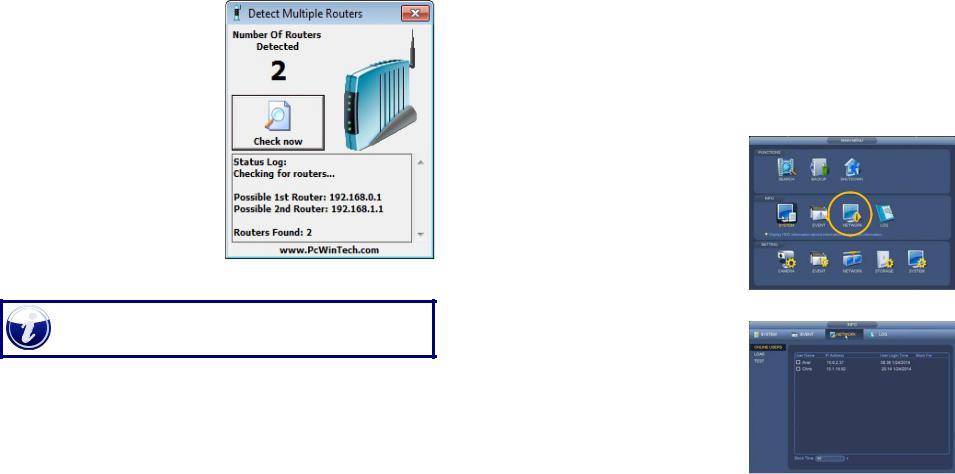
SETTING UP DMZ IN ROUTER 2
STEP 1. Login into Router 1 by putting the IP of Router 1 into the Internet Explorer browser, as in the example shown in Picture 1-25 where the IP address of Router 1 is 192.168.0.1
STEP 2. Find the status page on the router settings that shows the WAN/ Internet IP address and write it down this WAN IP address.
STEP 3. Log into the Router 2 by putting the IP of Router 2 into the Internet Explorer browser, as in example shown in Picture 1-26 where the IP address of Router 2 is 192.168.1.1
STEP 4. Find the DMZ page in the
router settings. |
|
STEP 5. Enter the WAN IP for Router 1 |
PICTURE 1-26 |
into the DMZ page and enable DMZ. |
|
NOTE! If you do not have a DMZ setting in the router, check to see if there is a Bridge setting. If so, then use the Bridge setting instead of DMZ.
STEP 6. Save your changes.
You have forwarded the ports on the router to which the DVR is connected, to the IP address of the DVR, and set the primary router to pass the connection to this router.
ADDITIONAL SETTINGS |
CHAPTER 2 |
2.1 ADVANCED NETWORK SETTINGS
Now that you’ve successfully connnected your NVR to your network and to the Internet, there are additional features which you can take advantage of. These settings allow your DVR to send out e-mail alerts as well as post images and records to an FTP site. In addition, you can see which users are online, limit online access and more.
ONLINE USERS
A list of users accessing the DVR from over the network or through the Internet is shown in Online Users menu which itself is found in the Network Info menu.
PICTURE 2-1
The user’s name as well as the IP address used to access the NVR is displayed.
If you have proper system management rights (Configured in Account, See Section 4.5 in the User’s Manual for full instructions), you can disconnect or block a user. The maximum time a user can be disconnected is 18 hours (65,535 seconds).
PICTURE 2-2
20 |
21 |
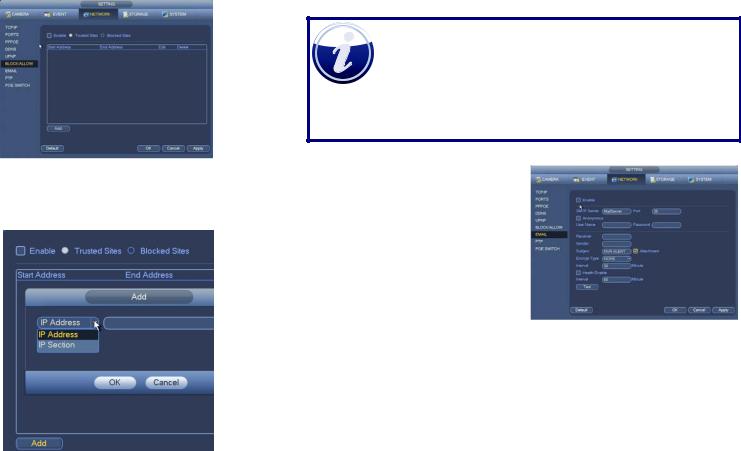
BLOCK/ALLOW LIST
You can also improve security by controlling remote access to your DVR using the IP Filter. If you Enable Trusted Sites, ONLY those on the trusted list will be allowed to log into the NVR from those locations, regardless of having correct user name and password. If Blocked Sites is enabled then no users from those IP addresses may log in. Up to 64 addresses may be entered.
Trusted Users
STEP 1. Select Block/Allow from the list on the left of the Network Settings menu.
STEP 2. Check the Enable box.
STEP 3. Choose Trusted Sites.
PICTURE 2-3
STEP 4. Click Add.
STEP 5. Enter the trusted IP addresses into the field at the top of the window and click Add.
Repeat for additional addresses and then select OK to save your list.
•If you want to block all users from an IP address, then select IP Section from the pulldown and enter the first two blocks of numbers for that IP address.
PICTURE 2-4
Blocked Users
This is set up the same way as Trusted Users. You only need to create one list or the other.
Several DVR functions allow you to send out e-mail alerts when specific events occur. Configuring this feature lets you set the DVR up to send out alerts via e-mail to a single recipient. You may need to contact your e-mail provider or IT department for some required information.
•You can add two more recipient emails using the Web Client software as shown in the
Secton 3.2.
NOTE! Depending upon your settings, the system can generate a lot of e-mail
alerts. For that reason, we recommend setting up a dedicated e-mail address specifically for the system to send alert notices. If you do not have your own e-mail system (such as a corporate mail server) you should consider using a
 free e-mail provider. However, because many free e-mail services allow only a limited amount of e-mail traffic we specifically recommend using Google’s Gmail service with
free e-mail provider. However, because many free e-mail services allow only a limited amount of e-mail traffic we specifically recommend using Google’s Gmail service with
its higher limit. Similarly, you will want the alert e-mails to go to a different account than the one sending them. This will ease your management of these alerts.
SMTP Server – smtp.(example).com |
|
|
Port – This is the port your mail provider uses |
|
|
User Name and Password – These are for |
|
|
the sending e-mail address and were |
|
|
set up when you created the e-mail |
|
|
account. |
|
|
Receiver – This is the recipient e-mail |
|
|
account. |
|
|
Sender – Example: QC DVR |
|
|
Subject – This is the subject line of e-mails |
|
|
generated by this DVR. |
PICTURE 2-5 |
|
Attachment – This allows the e-mail to |
||
|
||
include one or more snapshots as |
|
|
attachments |
|
|
Encryption – The system supports SSL and |
|
|
TSL encryption. |
|
22 |
23 |
